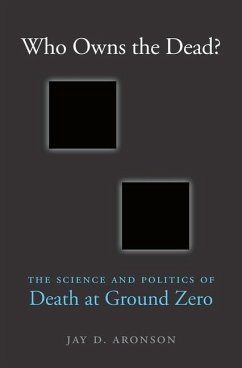After the 9/11 attack on the World Trade Center, Chief Medical Examiner Charles Hirsch proclaimed that his staff would do more than confirm the victims' identity. They would attempt to return to families every human body part larger than a thumbnail. As Jay D. Aronson shows, delivering on that promise proved to be a monumentally difficult task.
Aronson explores our commitment as a species to care for our dead through a beautifully written, intellectually serious, and deeply researched account of the emotionally, politically, and aesthetically fraught efforts to create the World Trade Center Memorial to the victims of 9/11. At the heart of his story are the dead of a sacralized space and their remains-fragmentary, many unidentified, so little in and of themselves-that collectively and name by name come to represent the contested meanings of an epochal event in modern history.
-- Thomas W. Laqueur, author of The Work of the Dead: A Cultural History of Mortal Remains
Elegantly written and richly researched, Who Owns the Dead? is an impressive work. Aronson carefully weaves together a set of distinctive and compelling stories that offers new insight into the ways America struggled with the task of recovering, identifying, and memorializing those who were murdered in the 9/11 attacks.
-- Edward Linenthal, author of The Unfinished Bombing: Oklahoma City in American Memory
Absorbing.
-- Brian Bethune Maclean's
Most Americans are familiar with the events of September 11, 2001. This in-depth narrative by Aronson describes what came next as Americans attempted to make sense of the tragedy and decide how it should be remembered. The book details government and private organizations' work to recover remains, identify victims, and build a memorial. The 9/11 Memorial raised financial and legal controversies as well as heated moral arguments about the nature of grief. There are dozens of titles devoted to the collapse of the towers, victims and survivors, terrorism, and international politics, but this volume offers a new angle on the domestic aftermath. Tragedy and the often conflicted human response do not make for light reading, but this selection, with its historical analysis of public memorials and forensic details of the DNA recovery, reveals insights into societal and cultural norms and how they are changing in response to technology.
-- Catherine Lantz Library Journal
Who Owns the Dead? is both a meticulous and illuminating look at how the victims of national disasters are honored on a massive scale, and at how complicated the task of public memory is.
-- Michelle Anne Schingler Foreword Reviews
The science of mass death is no easy thing to read or write about. It can, however, give us valuable insights into the way politics, technology, and a flood of grief can alter our perceptions of how we treat the dead...Aronson's account describes the recovery efforts amid the pandemonium after the [9/11] attack. This is sad, horrifying and often gruesome, but it is a story worth hearing.
-- Shaoni Bhattacharya New Scientist
Thoroughly researched, eminently judicious, powerful, and poignant...Most important, perhaps, Aronson emphasizes throughout his fine book that Americans must find ways to understand, respect, and respond to the immense burdens bereaved families carry, as well as the cultural, economic, and political implications of public commemorations of mass deaths.
-- Glenn C. Altschuler Philadelphia Inquirer
A thoughtful and solidly informed meditation.
-- Martin Filler New York Review of Books
-- Thomas W. Laqueur, author of The Work of the Dead: A Cultural History of Mortal Remains
Elegantly written and richly researched, Who Owns the Dead? is an impressive work. Aronson carefully weaves together a set of distinctive and compelling stories that offers new insight into the ways America struggled with the task of recovering, identifying, and memorializing those who were murdered in the 9/11 attacks.
-- Edward Linenthal, author of The Unfinished Bombing: Oklahoma City in American Memory
Absorbing.
-- Brian Bethune Maclean's
Most Americans are familiar with the events of September 11, 2001. This in-depth narrative by Aronson describes what came next as Americans attempted to make sense of the tragedy and decide how it should be remembered. The book details government and private organizations' work to recover remains, identify victims, and build a memorial. The 9/11 Memorial raised financial and legal controversies as well as heated moral arguments about the nature of grief. There are dozens of titles devoted to the collapse of the towers, victims and survivors, terrorism, and international politics, but this volume offers a new angle on the domestic aftermath. Tragedy and the often conflicted human response do not make for light reading, but this selection, with its historical analysis of public memorials and forensic details of the DNA recovery, reveals insights into societal and cultural norms and how they are changing in response to technology.
-- Catherine Lantz Library Journal
Who Owns the Dead? is both a meticulous and illuminating look at how the victims of national disasters are honored on a massive scale, and at how complicated the task of public memory is.
-- Michelle Anne Schingler Foreword Reviews
The science of mass death is no easy thing to read or write about. It can, however, give us valuable insights into the way politics, technology, and a flood of grief can alter our perceptions of how we treat the dead...Aronson's account describes the recovery efforts amid the pandemonium after the [9/11] attack. This is sad, horrifying and often gruesome, but it is a story worth hearing.
-- Shaoni Bhattacharya New Scientist
Thoroughly researched, eminently judicious, powerful, and poignant...Most important, perhaps, Aronson emphasizes throughout his fine book that Americans must find ways to understand, respect, and respond to the immense burdens bereaved families carry, as well as the cultural, economic, and political implications of public commemorations of mass deaths.
-- Glenn C. Altschuler Philadelphia Inquirer
A thoughtful and solidly informed meditation.
-- Martin Filler New York Review of Books






